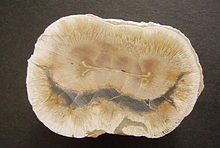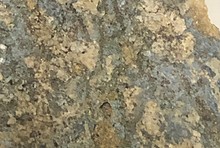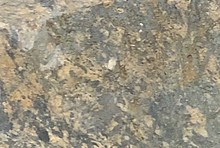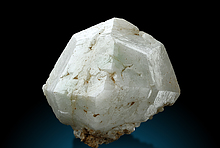The Richardson (Fission) Mine, Wilberforce, Ontario
Last Updated: 14th Dec 2008By Daniel Russell
Early History of the Richardson Mine (aka Fission Mine)
Wilberforce, Cardiff Township, Ontario Canada
Wilberforce, Cardiff Township, Ontario Canada
by Daniel E Russell
The Richardson Mine (later known as the Fission Mine) is located about one mile east of the village of Wilberforce, on Lot 4, Concession XXI, in Cardiff Township of Ontario, (approximately Latitude: 45.0566N Longitude 78.1797W). It is noteworthy for producing some of the largest crystals of uraninite in Canada, reaching 2.3 kilograms in weight (Meen, 1948)
The initial discovery of uraninite at the Richardson Mine site was made in 1922 by a former Yukon prospected named W. H. Richardson, who had been drawn to the area by news of the discovery of a molybdenite deposit (the Wilberforce Molybdenum Mine) and began to systematically prospect the region. He discovered a black mineral of high specific gravity on a surface pegmatite outcropping, which after comparison to a sample of Czech pitchblende he correctly identified as uraninite.
There was little industrial interest in new sources of uranium in the late 19th and early 20th centuries. However, after Marie Skłodowska-Curie announced the isolation of radium from uranium ores in 1898, followed by the announcement in 1903 that radium had successfully cured cancer, interest in uranium deposits as a source of what was then the most valuable metal on earth (valued at $70,000 a gram) skyrocketed. Countries around the world scrambled to produce their own radium. Richardson's prospect appeared to be Canada's best chance to gain a foothold in the marketplace.
The process of recovering the minute quantities of radium that occurred in uranium ores involved an agonizingly slow process of fractional crystallization. By 1929, there existed only 300 grams of purified radium on earth.
In 1927, the Ontario Radium Corporation, Ltd purchased the property with the intent to mine uraninite as a source of radium. Development work on the site was begun in 1929.
Even Time magazine noted the activity on Richardson's property:
Richards is today considered to be the “father of Canadian radiation oncology.” The fact that early in his career as a physician he had seen service as staff physician in a mining camp in British Columbia may have lead him to decide to attempt to mine the radium he desperately needed for his research and treatment program.Because radium is one of the most useful and expensive things in the world, the discovery of even a small new source is more important than the discovery of fields of gold. Last week despatches from Ontario announced that Canadian mine experts had found a. radium mine near Wilberforce. Three years ago miners in the district discovered traces of uraninite (uranium oxide) in pegmatite, a type of rock rich in valuable minerals. Where there is a uranium deposit, mine experts have learned to look for radium. Uranium, producer of radium, is constantly emitting rays, changing its internal structure until it has disintegrated into radium.
Scratching away the loose dirt covering the rocky deposits, miners found a vein especially rich in uranium oxide. Although the extent of the discovery is not definitely known yet, investigation so far has shown it to be a strip from five to ten feet wide and over one mile in length. Uraninite is scattered throughout the deposits.
Soon as news of the discovery spread, people came running with money to buy the mine. One gram of radium sells to-day for from $50,000 to $70,000. A group of Canadian doctors finally succeeded in buying several hundred acres around the discovery. Headed by Dr. Gordon Earle Richards, head of the X-ray department, Toronto General Hospital, and Dr. George William Ross, they organized Ontario Radium Corp. Last year they sent samples of their ore to England. There it was refined, meeting satisfactorily all necessary tests. The doctors found that one ton of their ore yielded 186 milligrams of radium.
By 1929, the surface workings at the Richardson Mine were primarily limited to exploratory pits and trenches.
Geologically, Spence and Carnochan (1930) interpreted the host rock as a syenite pegmatite. Hogarth et alia (1972) describe the country-rock as “variably syenitized biotite-gneisses and amphibolites” with marble, which were cut by calcite-cored vein-dikes, “in which the core zone constitutes a substantial proportion of the whole mass. The bodies are generally more or less tabular, with crystals projecting inward from the walls. Some of the crystals are partly cavernous and enclose semi-isolated masses of the core-materials.” They added that “the composition and structure of these vein-dikes indicate origin by hydro-thermal "fluxing" and recrystallization of wall rocks along bedding planes, joins, and other fractures.”
West Pit:
The first discovery of uranium on the site was made in the vicinity of the West Pit, a narrow cut in the pegmatite about 50 feet long and 6 to 8 feet deep. This cut provided a 200 pound sample of uraninite which, in 1923, was assayed at about 7.82 milligrams of radium per short ton. The pegmatite here contained miarolitic cavities, “some of them of considerable size, their walls being lined with well-developed feldspar crystals.”
Middle Pit:
This exploratory excavation was begun in the Spring of 1929, when a promising-looking outcrop was stripped to expose the syenite pegmatite. Numerous miarolitic cavities where uncovered in this area, including one cavity which produced well formed feldspar crystals to 6 inches in length.
The East Pit:
Located about 2,000 feet from the West Pit, only small inclusions of uraninite were observed here.
“Fluorite Shaft”: Spence and Carnochan note the position of a “Fluorite Shaft” in the south-western portion of their diagram of the site (see above) and state that some trial work for fluorite had been conducted on the site (prior to Richardson's claim to the site?) but offer no further details.
Minerals Observed in 1929
Apatite: the Richardson Mine was noteworthy for its production of large, euhedral apatite crystals, some reaching 13 kilograms. Spence noted that “good terminations are rare, the ends of the crystals seeming to have been attacked and being pitted and rounded,” adding that “clear fragments of considerable size and without visible flaws can often be picked from the broken crystals”(Spence and Carnochan, 1930). The color ranged from brownish green to brown to yellow.
Biotite: large plates of biotite were observed in the calcite veins of the West pit. No significant amounts of biotite were noted in the Middle Pit.
Calcite: The calcite vein-dike fillings were usually composed of pinkish, fine grained calcite; the color of the calcite changed to a brownish red in close proximity to uraninite crystals or masses. This was believed to be an accurate indicator for the presence of uraninite.
Feldpar: Generally the feldspar was buff to reddish in color. Spence and Carnochan (1930) believed the feldspar to be predominant orthoclase but had conducted no study of the material. It occurred as well-formed crystals in the miarolitic cavities but was not observed as euhedral crystals in the calcite-fluorite vein-dike fillings.
Fluorite: Fluorite was a major component of the calcite vein-dikes. It varied on color from reddish purple to violet, becoming almost black when in proximity to uraninite. Spence and Carnochan state that the color fades on exposure to sunlight and eventually becomes colorless. The fluorite released a noxious ozone-like odor when freshly broken, which was “of practical service to the workman as an additional indication that they are breaking into a pocket of uraninite”. This fluorite was of the variety known as “antozonite” (the classic “stinkspat” or “stinkflus” type of fluorite, a hallmark of many of the classic German uranium deposits).
”Hornblende”: Associated with the calcite-fluorite vein-dike filling was of an amphibole-group mineral occurring as free crystals to 12 inches in width. Spence and Carnochan describe this material as “hornblende.” Tim Jokela's website, “Ontario Minerals”contains the following comment:
Magnetite: Magnetite occurs both at anhedral masses and large euhedral crystals, commonly intergrown with apatite, “hornblende” and uraninite.Clinoamphibole.
The Richardson (Fission) Mine, Wilberforce district, is said to be a source of cutting-grade emerald green material. This isn't a recognized species, it's a puzzle which amphibole species it is. Sabina(1986), p.80.
Molybdenite: occurs as small flakes in the pegmatite
Torbernite: Spence and Carnochan note the presence of torbernite as “traces” of no commercial interest.
Uraninite: in addition to pea-sized “nodular lumps,” the Richardson Mine uraninite occurs as large euhedral crystals. One of the largest uraninite crystals discovered in Canada was from the Richardson, weighing in at an impressive 5 pounds (Meens, 1948). Gross chemistry of one crystal recovered in 1929 showed, in addition to uranium, 11.4% thorium, 10.4% lead (both reported as oxides), and traces of cerium, yttrium, magnesium, calcium, manganese, iron and silicon.
Zircon: zircon was observed only as a minor rock-forming mineral in the pegmatite, usually forming crystals with a maximum length of 3/8ths of an inch.
Bibliography
Hogarth, D.D., Moyd, L, Rose, E.R. and Steacy, H.R.
Classic Mineral Collecting Localities in Ontario and Quebec.
International GeologicalCongress 24, Montreal, Excursion Guidebook A47-C47, [reprinted as GSC Misc.Pap. 37] (1972)
Jokela, Tim Jr
Ontario Gems & Lapidary Materials
http://www.ontariominerals.com/ontario_lapidary.htm
Meens, Victor B.
A Unraninite Crystal of Unusual Size
University of Toronto Studies, Geology Series No. 52
Toronto 1948
Spence, H S and Rogers, R A
The Wilberforce Radium Occurrence
Investigations of Mineral resources and the Mnining Industry, 1929
Department of Mines, Canada No. 719 (1930)
Steacy, H.R., Rose, E.R., Moyd, L. & Hogarth, D. D.
Some Classic Mineral Localities of Southeastern Ontario
Mineralogical Record Vol. 13, No. 4 (July-August 1982)
Time (1930)
“Radium in Ontario”
Time magazine, 13 Oct 1930
Article has been viewed at least 15941 times.

















From Spence and Carnochan